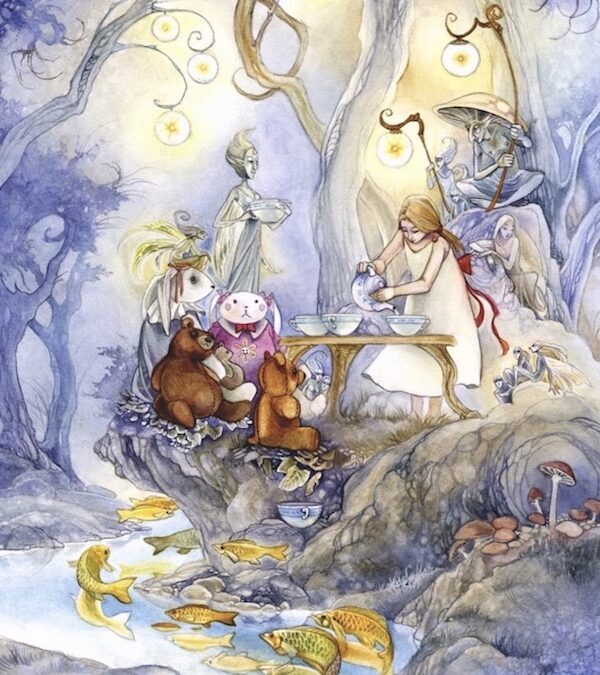Let’s dive into the magical world of a child’s mind and the paths they walk with their beloved fairy tale friends.
Despite the digital world that we live in today, fairy tales are still important as they carry important benefits for children’s well-being. Tales speak a child’s language and allow them to feel their emotions in safe and healthy ways, even when they can’t make sense of them. Tales nurture children’s imagination, while relieving their worries and fears. In many ways, tales offer children coping mechanisms and comforting hands during their intense moments of childhood. Tales also allow us, as a family, to cultivate and nurture a loving space of connection and more closeness.

“Little Thumb” by Charles Perrault, illustrated by Gianni Benvenuti
It is no easy task being a child. Real childhood is full of adversaries, unknowns, and intensities. Along the way, our little ones are faced with some harsh realities of their larger-than-life dreams as they come to not being realized. They face the mysterious hands of “No” when they want candy at midnight, or to watch yet another movie or, in the past couple of years, want to play without a mask. These mysterious hands of “No” remain mysterious for reasons our children are not capable of understanding yet. And no matter how much we want to shield and protect them as parents, childhood, as life itself, will always have its own intensities.
Hope is often the through-line of tales’ narrative, though the teaching isn’t that it’s easy. Hope doesn’t always get us out of trouble like fairy dust or Aladdin’s genie from the lamp. Hope is a struggle. Hope can be challenging. Yet hope is absolutely necessary because we need to learn to meet the world with hope.
It is true that a lot of tales are quite dark and even frightening, which is often the concern of some parents. We might wonder, “Should we be telling such stories to our children then?”

“Tales from Moominvalley” by Tove Jansson
Based on Jungian psychology, yes. They are nothing to fear and actually teach children how to deal with life’s challenges, conflicts, and desires in a healthy way. The seeming violence or darkness within the tales is usually contained within a reasonable and satisfying structure. Both good and bad are separated clearly, leaving no grey areas for confusion. From a psychological perspective, this is important for children because, unlike adults, children only have their emotional body forming until the age of seven. In other words: Without the mental body well formed to rationalize, small children perceive the world only through their emotions and feelings, and they may not have the tools yet to navigate through ambiguity. The appearance of villains and evil people allows the child to freely, and safely, project its own violent feelings onto these characters in a clear and separated manner.
Since most children are unable to express their anger, sadness and even hatred, because they depend on the adults in some shape or form, the children can therefore place these natural emotions and aggressions as personified by the tales’ villains, rather than suppressing them.
Simultaneously, since their emotions are expressed in a satisfying manner, children can then identify with the good characters. They have now won against the dragon, escaped the witch through the thorns of the scary forest, and can now acquire their justice after their hardships. It might seem non-sensical to us, or even absurd and unhealthy, but children have their own unique emotional wild lands, and they need to be able to process emotions in such a way. Children can also identify with the weak and tiny in the tales, who are able to overcome all odds and still triumph, like the little mouse, the bunny or the poor shoemaker. Tales permit the expression of our natural human emotions, while preserving the essentials of life: hope and love.

“The Fairies” by Charles Perrault, illustrated by Gianni Benvenuti
“Diamonds and gold coins may
Work some wonders in their way;
But a gentle word is worth
More than all the gems on earth.”
In “The Snow Queen” by Hans Christian Andersen, little Gerda goes through so many obstacles along the way. It is a powerful story about love, about trust, about believe – it is a story about the power of the heart, and what to do when we feel the coldness upon us.
Who hasn’t like Gerda been exiled from the familiar comforts of the world they once knew? Who hasn’t had a dream or a person taken away? Who hasn’t faced challenges, when mysterious hands reached out to limit our reality? Who hasn’t had a deep yearning that no one else, aside from just one person, could have soothed? Who hasn’t felt lost in the forest, almost lost hope, and just then, a helping hand held us to guide us forward?
And like Kay, who hasn’t experienced despair and a frozen heart, felt lost and isolated from what once warmed our tender heart? Who hasn’t felt estranged in an unknown land, fallen into a strange new world? Who hasn’t sometimes retreated into a fortress, which shined bright as ice, yet was lonely and colourless inside because there was something still missing? Who hasn’t surrounded themselves with the logical and material, just to soothe the self, yet their soul was still yearning? Who hasn’t met a cold ice queen or king? And who hasn’t negated their own self, believing themselves unworthy and unloved?
In “The Snow Queen”, as in most other fairy tales, we learn that the greatest magic of all is the power of love:
“And the magic woman said,
‘Yes, I can tie all the winds and storms with a single thread. But I cannot give her any greater power that what she has already. Don’t you see how strong that is? How men and flowers and animals serve her and help her, and how well she got through the world, barefoot as she is? She cannot receive any power greater than what she has now, which is held in her own purity and innocence of heart. It is only this love that can defeat snow kingdoms and melt the ice from Kay’s heart. And even with all my magic, I bow to such power.’”
We have to remember that children are fragile, helpless and completely dependent. And in these ancient tales, they find a comforting hand, holding them through it all. Especially in the times when their worlds seem confusing and they don’t know how to make sense of it, when they don’t even know what questions to ask us, it is the tales that speak to them in a language that they understand. While we as adults may have forgotten these magical languages, children know them, feel them and need them.
Children need stories and tales, because they relate to the characters who, just like them, feel all the spectrum of emotions, and as such, they feel more comfortable feeling their own emotions as well. Children can look at these tales like a beloved friend and feel less alone when they face adversaries.

“The Snow Queen” by Hans Christian Andersen, illustrated by Edmund Dulac
In an age where everything is increasingly dehumanized, as people are turned into non-people soon to be robots, just faces on a screen, swipeable and disposable, and where even culture and art seem to diminish our lives as opposed to enriching it, it is precisely tales that offer a much needed link to the values of humanity and humaneness.
When I was a little girl, every time I’d listen to a tale, I’d have to use my imagination. I’d have to first believe it, to then see it. Aside from the power of the heart, the power of our mind is our other greatest gift in life. We need our imagination, rather than the purely visual instant gratification/stimulation that we get from TV or media. It helps broaden our perception, so that we see beyond the veils, beyond the conditioned understandings and limited beliefs and thought structures. It helps us co-create. It is also imagination that makes the best and most innovative change-makers and problem-solvers in the world. Imagination also makes us creative, and fulfilled in life. We shouldn’t rob children of their imagination, because this ultimately affects their well-being.

“Among Gnomes and Trolls” illustrated by John Bauer
Fairy tales are also the first teachers to children, and storytelling itself was the first teacher of all humanity – threads of wisdoms secretly living continuously in the stories, weaving in and out of our lives, passed down from generations and generations. For these were not only just stories heard, but stories we went into. We lived in them and the characters. We struggled with them. We sharpened our instincts in the deep scary woods. And we learned perseverance through the obstacles and failures. Our ever after had to be earned and not everyone got to it. We know the value of it.

“The Snow Queen” by Hans Christian Andersen, illustrated by Christian Birmingham
And we, as them, learn to cope with life, also. Some even remember the magical powers of love. There has been numerous research showing that children who grew up with fairy tales had healthier coping strategies during hard times.
Of course, not all fairy tales have happy ends, especially if we’ve read Oscar Wilde, Hans Christian Andersen or many of the Swedish tales. But there’s wisdom in that too – as it shows us that we shouldn’t be so hard on ourselves if we fail at something; and it helps us not to feel a sense of defeatedness in life when “not all hard work pays off”. Yet we also remember to trust ourselves still, that all we can do sometimes of weave and shape from our feet and hands. And take steps. Little steps. One foot after the other. Lightly, slowly. And who know what is waiting around the corner? We never know who might show up in our story, during our uncertainties and doubts and fears, on the next page the sun might be waiting. It could be kindness from the hand of a stranger, or a firepit in the cold forest.
The lessons from tales are subtle but they will stay in the subconscious mind through adulthood. In many ways, these are the moral and humane structures and foundations of the life that we build for ourselves. Storytelling is powerful.
And we learn to persevere.
And we learn to trust.
And some learn to love.
It is easy for us as adults to sometimes rest in cynicism, and with so much doubt, fear and uncertainties that we face, we ourselves are going though our own hardships. But we must also shift our eyes towards our little ones, who just like us faced their own hardships during these times of the past few years; they faced the intensities feeling the unknown around them and the instabilities of change. And while they can rarely shape emotions into words at young age, tales can help them tremendously, like a beloved friend would.

Illustration by Julia Jeffrey
While we can’t protect our children from the world and all its worries, we can hold them through it.
We can show them how even when things are uncomfortable, there is a way forward.
We can show them how hope is the through-line of the narrative.
We can show them that no matter how muddy waters get, no matter how wide forest trees hide things from our eyes, the whisper of love will guide us along the leafy twists and turns of life’s paths, always.
We’ll tell them all about these little wisdoms, as they lay their tiny heads upon our laps and look at us with big bright eyes, while we read them a story tonight.
It’s a story of love after all.
Because it’s a loving space of connection and closeness that we’ll share.
Isn’t that magic?

For more of my writings, browse through my Art of Love.
If you wish to support me and my work, you may do so by sharing it or donate here. For personal readings with me, you may visit my Offerings.
Your support means so much to me! Thank you wholeheartedly!
Cover illustration by Stephanie Pui-Mun Law.
All other illustrations are from my own collection of fairy tale books.




